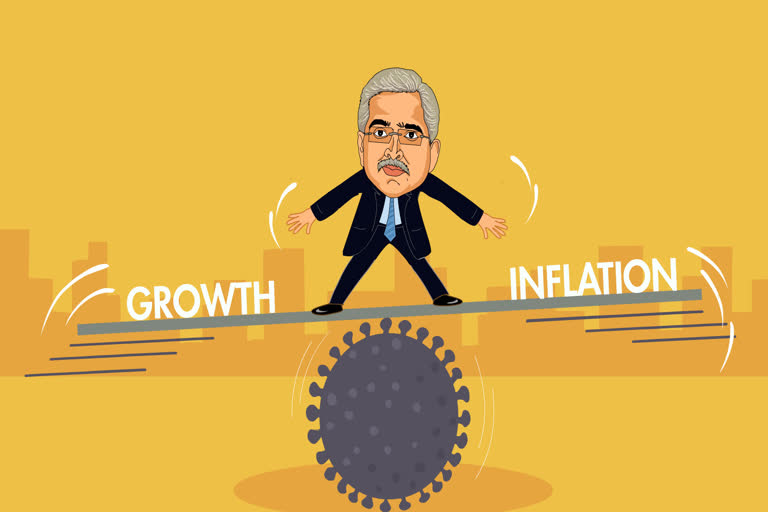With inflation hovering slightly above the RBI’s target range of 4 percent plus/minus 2 percent coupled with a fragile growth environment, RBI’s Monetary Policy Committee (MPC) had to do a tightrope walk of balancing both growth and inflation concerns.
In its monetary policy statement, the MPC chose to keep the policy rate unchanged, while retaining an accommodative stance. The Committee also decided to keep the Reverse Repo rate and the Marginal Standing Facility rate unchanged. This seems to be a prudent decision in the present uncertain situation.
Amid a sharp collapse in demand, the surge in inflation over the last three months was primarily on account of the lockdown led supply chain disruptions. With the resumption in economic activity, these disruptions are expected to ease. However with a surge in infections, and imposition of localised lockdowns, the easing of supply chain disruptions could be delayed.
Hence it is desirable to wait for more data on food and non-food inflation before taking a call to raise interest rates. The MPC does expect inflation to moderate in the second half of the year led by a bumper Rabi harvest.
The growth considerations seem to have also influenced RBI’s decision to keep the rates unchanged. High frequency indicators like the Purchasing Managers Index (PMI) indicate that growth picked-up in June, however the improvement seems to have plateaued in July. More data points are needed to assess the trajectory of growth. An accommodative stance by RBI however signals that it stands ready to cut rates to support growth as and when inflation slows.
Another pertinent reason for not cutting rates seems to be that the RBI has already cut the policy rate by 115 basis points since March 2020. They note that the transmission to bank lending has improved. The Weighted Average Lending Rate (WALR) declined by 91 basis points during the March to June period.
The RBI has adopted a wise stance to wait for rate cuts to transmit further before announcing additional rate cuts. As front-loading of rate cuts has already happened, the RBI would like to judiciously use the limited space for further rate cuts.
Promising announcements
While the RBI announced a pause on rate cuts, there were noteworthy announcements on the regulatory front. In continuation of a series of support measures for MSMEs, the RBI announced a framework for restructuring of loans to MSMEs. Those MSME loans which were categorised as “standard” as on March 1, 2020 would be eligible for restructuring.
This announcement provides a major relief to those MSMEs whose loans may have slipped into NPAs from March 2. These loans would not be categorised as NPAs subject to the condition that the lending bank would have to maintain an additional provision of 5%. This will aid in cushioning the adverse economic fallout of the Covid-19 pandemic for MSMEs as a significant proportion of MSMEs stare at business losses and closure.
The one time restructuring scheme is also made available to corporate loans and personal loans. Drawing upon the previous episodes of restructuring which resulted in large scale extend and pretend and hiding of bad loans, the restructuring framework has been subject to a number of checks and balances.
First, only those borrowers who were classified as standard and not in default for more than 30 days as of March 1 would qualify for this scheme.
Second, the invocation of restructuring has to be implemented by 31st December, 2020.
Read more:Now, you can borrow more against gold
Third, a host of disclosure requirements have been laid out for banks pertaining to restructured loans.
Finally, a committee has been set up to oversee validation of resolution plans above a specified threshold.
The intent of the safeguards seem to be to help those businesses who were on their way to repay loans but have been hit hard due to the Covid-19 outbreak.
Another significant announcement relates to Priority Sector Lending (PSL). The RBI has announced that the scope of the scheme would be widened to allow for more entities such as Start-Ups. Additionally, the limits for some of the other sectors like renewable energy and small and marginal farmers would be increased. That the RBI intends to use the PSL as an instrument to mitigate regional disparities and further financial inclusion is reassuring.
Overall, the decision to keep the policy rate unchanged seems to be in keeping with the present uncertain scenario. The RBI has also accommodated industry demand by focussing on loan restructuring. The hope is that with a system of checks and balances in place, the asset classification forbearance doesn’t encourage the old extend-and-pretend setting.
(Radhika Pandey is a Fellow at the National Institute of Public Finance and Policy, New Delhi. Views are personal.)



